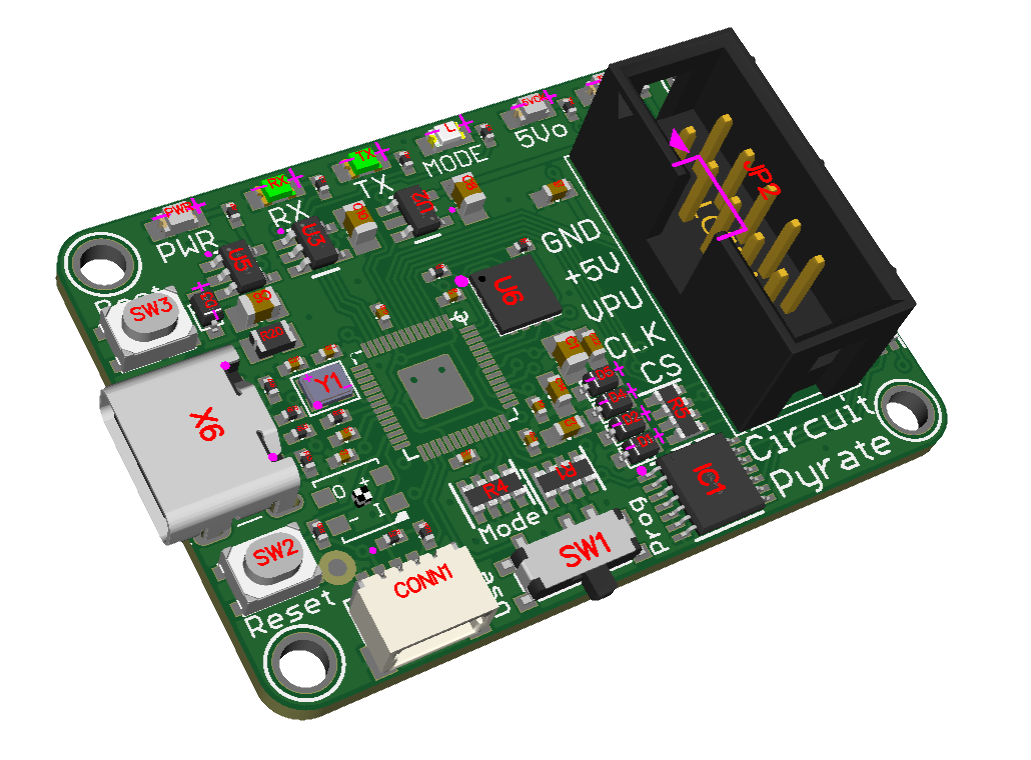



⚓️🏴☠️🤖🔧💻🔗🐍🔋📚💡🔌✨🌐💬📌🔄🔍💼📊
we recently sold out of our stock of Bus Pirates https://github.com/BusPirate/Bus_Pirate and when we booked a reorder we found it’s currently unavailable with no ETA for re-stocking. it made us think about revisiting this design, perhaps using an RP2040 instead: with native USB and CircuitPython and PIO it might be easier to add new protocols! we did do a “Circuit Pyrate” draft many years ago but it was based on the SAMD21 and we quickly ran out of space – another thing the RP2040 would excel at.
parsing data is something that Python does very well, and tannewt already has VT100 control code support for the REPL status bar, so we’re having a go at re-implementing the UX in native python by instantiating a secondary ‘data only’ CDC UART endpoint https://learn.adafruit.com/customizing-usb-devices-in-circuitpython/circuitpy-midi-serial#usb-serial-console-repl-and-data-3096590 The default REPL can then be enabled or disabled with the onboard slide switch.
here’s our draft that uses the same sizing and header location but of course all different parts. two challenges: the RP2040 is not 5V-tolerant like the PIC24J but it’s also not guaranteed for high speeds, so we put a 1K+3.6V zener diode on the 4 GPIO pins that ought to let it work OK with 3 or 5V devices. secondly, the pin mux distribution for I2C and UART doesnt match the same as the original chip so we may have to PIO bitbang those interfaces. we’re going to have to do a bunch of pin twiddling to find out the limitations of this design. we add a separate Stemma QT port, NeoPixel, and LEDs for both power outputs. fun fact, did you know that the bus pirate is CC-0 http://dangerousprototypes.com/docs/Bus_Pirate_v3.6#License a rarely seen license for OSHW!
our current pondering is how to best mimic the 5V tolerant inputs of the PIC24J – the 1K + 3.6V zener will definitely do the job but can slow down the IO quite a bit on those high speed SPI lines. because we want full bidirectional support for each pin *and* be able to enable/disable optional 10K pullups to 3V (internal) or 5V (external) we can’t us the TXS0104 series: has built in un-disableable pullups. this app note has a few tips we’re perusing https://ww1.microchip.com/downloads/en/DeviceDoc/chapter%208.pdf – #11 looks like it may work..any suggestions?
- SEO Powered Content & PR Distribution. Get Amplified Today.
- PlatoAiStream. Web3 Data Intelligence. Knowledge Amplified. Access Here.
- Minting the Future w Adryenn Ashley. Access Here.
- Buy and Sell Shares in PRE-IPO Companies with PREIPO®. Access Here.
- Source: https://blog.adafruit.com/2023/05/08/yaaarrr-a-circuit-pyrate-is-ready-to-be-your-best-mate-on-the-hacking-seas/
- :has
- :is
- :not
- 10K
- a
- Able
- About
- add
- ago
- All
- already
- also
- an
- and
- Another
- any
- app
- AS
- At
- bar
- based
- BE
- because
- BEST
- Bit
- both
- built
- Bunch
- bus
- but
- by
- CAN
- CDC
- challenges
- chip
- code
- control
- course
- Current
- Currently
- data
- Default
- definitely
- Design
- Devices
- DID
- different
- disabled
- distribution
- do
- does
- down
- draft
- each
- easier
- enabled
- Endpoint
- Excel
- external
- few
- Find
- For
- found
- full
- fun
- Go
- going
- guaranteed
- hacking
- Have
- having
- High
- How
- How To
- http
- HTTPS
- i2c
- in
- inputs
- instead
- interfaces
- internal
- IT
- Job
- jpg
- Know
- License
- like
- limitations
- lines
- location
- LOOKS
- made
- many
- Match
- max-width
- May..
- might
- native
- New
- no
- of
- on
- Onboard
- or
- original
- our
- out
- parts
- perhaps
- pins
- Pirates
- plato
- Plato Data Intelligence
- PlatoData
- power
- put
- Python
- QT
- quickly
- ready
- recently
- same
- secondary
- seen
- separate
- Series
- Slide
- slow
- So
- sold
- something
- Space
- speed
- speeds
- Status
- stock
- support
- Switch
- that
- The
- then
- thing
- think
- this
- those
- tips
- to
- two
- us
- usb
- using
- ux
- very
- want
- was
- we
- WELL
- when
- will
- with
- Work
- would
- years
- you
- Your
- zephyrnet












